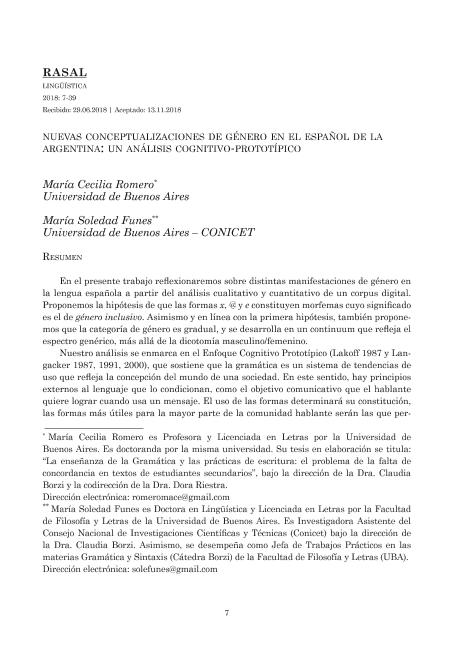Artículo
En el presente trabajo reflexionaremos sobre distintas manifestaciones de género en la lengua española a partir del análisis cualitativo y cuantitativo de un corpus digital. Proponemos la hipótesis de que las formas x, @ y e constituyen morfemas cuyo significado es el de género inclusivo. Asimismo y en línea con la primera hipótesis, también proponemos que la categoría de género es gradual, y se desarrolla en un continuum que refleja el espectro genérico, más allá de la dicotomía masculino/femenino. Nuestro análisis se enmarca en el Enfoque Cognitivo Prototípico (Lakoff 1987 y Langacker 1987, 1991, 2000), que sostiene que la gramática es un sistema de tendencias de uso que refleja la concepción del mundo de una sociedad. En este sentido, hay principios externos al lenguaje que lo condicionan, como el objetivo comunicativo que el hablante quiere lograr cuando usa un mensaje. El uso de las formas determinará su constitución, las formas más útiles para la mayor parte de la comunidad hablante serán las que perduren y la gramática emergerá del discurso como un conjunto de rutinas recurrentes más o menos gramaticalizadas constantemente renegociadas en el habla (Hopper 1988). La gramática en este marco se encuentra motivada y sujeta al cambio, porque el hablante usa la lengua en pos de un objetivo comunicativo puntual. In the present paper we will reflect on different manifestations of GENDER in the Spanish language from the qualitative and quantitative analysis of a digital corpus. We propose the hypothesis that the forms x, @ and e constitute morphemes whose meaning is that of inclusive gender. In relation with the first hypothesis, we also propose that the gender category is gradual, and develops in a continuum that reflects the generic spectrum, beyond the masculine / feminine dichotomy. Our analysis is based on a grammatical approach that allows us to analyze these forms as opposed to other approaches whose basic principles prevent it. The Prototypical Cognitive Approach (Lakoff 1987 & Langacker 2000) argues that grammar is a system of usage trends that reflects a society’s conception of the world. In this sense, there are principles external to the language that condition it, such as the communicative objective that the speaker wants to achieve when using a message. The use of the forms will determine their constitution, the most useful forms for most of the speaking community will be those that endure and grammar will emerge from discourse as a set of recurring routines more or less grammaticalized and constantly renegotiated in speech (Hooper 1988). The grammar in this frame will be motivated to change and subject to change because the speaker uses the language in pursuit of a specific communicative objective.
Nuevas conceptualizaciones de género en el español de la Argentina: un análisis cognitivo-prototípico
Fecha de publicación:
06/2019
Editorial:
Sociedad Argentina de Estudios Lingüísticos
Revista:
Rasal Lingüística
ISSN:
2250-7353
e-ISSN:
2618-3455
Idioma:
Español
Tipo de recurso:
Artículo publicado
Clasificación temática:
Resumen
Archivos asociados
Licencia
Identificadores
Colecciones
Articulos(SEDE CENTRAL)
Articulos de SEDE CENTRAL
Articulos de SEDE CENTRAL
Citación
Romero, María Cecilia; Funes, María Soledad; Nuevas conceptualizaciones de género en el español de la Argentina: un análisis cognitivo-prototípico; Sociedad Argentina de Estudios Lingüísticos; Rasal Lingüística; 2018; 6-2019; 7-39
Compartir




